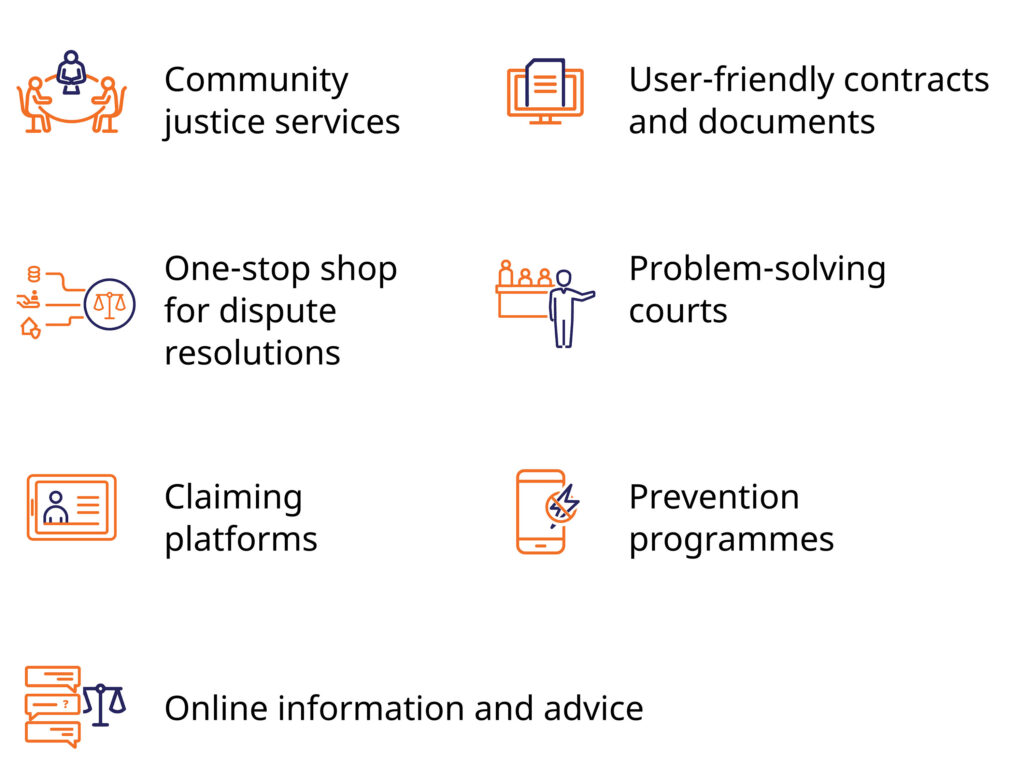Overview of the report
Trend Report 2021 – Delivering Justice / Overview of the report
Overview of the report
This report is based on HiiL’s many years of collecting data about people’s justice needs and experiences. This work was done together with partners including the World Justice Project, UNDP, the OECD and the Open Society Justice Initiative.
We had conversations with many ministers of justice, chief justices and their immediate teams. They told us about their struggles to set agendas, get them funded and implement them effectively. Dialogues with stakeholders aimed at pathways for reform, now one of the core activities of HiiL, have been an invaluable source of information.
The report is also based on working with many legal help organisations, in Africa and the MENA region, and also in Bangladesh, Indonesia, Ukraine and Western Europe, including our home country, the Netherlands. These organisations operate close to the people that experience the access to justice gap: mothers, fathers, workers, landowners, victims of crime, perpetrators of aggression, clients of public services and small businesses. We saw how legal help organisations interact with law firms, government bodies and religious organisations to deliver more effective justice.
In our work with justice innovators we have been close to the realities and experiences of more than one-hundred justice start ups in the past six years. Why did they fail? What allowed them to succeed? What do they and their funders need?
The team further explored this in case studies for this report regarding Legal Zoom in the US, problem-solving courts in several countries, houses of justice in Colombia, a criminal justice case-management system in Sierra Leone and local council courts in Uganda.
Our trend reports integrate these experiences with the latest research on access to justice. Academic research from many disciplines is contributing to this challenge. Evaluations and best practices inform the field and an informal coalition guides the research and developmental work to support people-centred justice. Our work greatly benefits from intensive dialogues and project cooperation with colleagues from the World Justice Project, UNHCR, the World Bank, Namati and the Open Government Partnership
People make the case
In Chapter 1, we provide examples of task forces and how they organised during the 2010s. We show how an international best practices approach is emerging. Access to justice initiatives by the Pathfinders for Peaceful, Just and Inclusive Societies, the OECD and the EU is supported by a network of specialised organisations working on the rule of law and access to justice including HiiL. One of the driving forces is Sustainable Development Goal 16:
Promote peaceful and inclusive societies for sustainable development, provide access to justice for all and build effective, accountable and inclusive institutions at all levels.
The case for developing sound justice strategies is now moving hearts and minds. Injustice is a powerful motivator. When injustice is systemic, people gather on the streets to ask for fairness and redress. When the effects of globalisation threaten livelihoods, feelings of injustice heighten. A task force ideally also engages with positive emotions. Justice encourages finding peace, improving relationships and enabling growth.
The business case for improving access to justice is strong and can be quantified. Justice problems occur frequently. In a typical megacity or state with eight million people, 1 million residents will experience a pressing justice problem each year. Half of those problems will have a major negative impact. The annual burden of injustice imposed by only one category of problems (land justice, employment justice, crime) can easily add up to hundreds of millions of euros.
This calculation illustrates what can happen if the justice ecosystem fails to give people a voice and provide effective remedies. Data suggest that a substantial proportion of the population will experience feelings of frustration or neglect within a few years.
Governments across the world rightly see this as a threat to stability. In 2011, the World Bank already established the link between effective grievance mechanisms and the prevention of armed conflict.
The business case is also positive: more fairness will improve well-being. When people are relieved of an existential threat to their livelihood and can manage their relationships through more effective contracts, their contribution to the economy can grow.
Future-focused, well-scoped and smart about implementation
In Chapter 2, we look at how justice leaders are coming together in various kinds of groupings. In this report, we call them task forces: multidisciplinary groups that have committed to improving access to justice in one way or another. These task forces appear because ownership for the quality of justice is unclear and distributed among several institutions, each working independently. Court managers, administrative (labor, housing, family) agencies, ministries, prosecutors, private suppliers of justice services and “justice startups” need the skills, resources and resilience to navigate these challenges. We detail how justice task forces have been formed, how they build up legitimacy and what can be learned from their experiences.
Task forces need to be resourced in a way that matches the size of their challenge. Early on, they envision a pathway forward, which includes implementation in terms of budgets and operations. They are familiar with the political, legal, administrative and financial environment. Most importantly, task forces build coalitions that ensure that their plans and designs become a reality. Smart task forces know how to turn ideas into organisations, programmes and policies by harnessing the public and the private sector’s potential.
In the past, task forces have carried out ambitious analyses of justice gaps. They have identified flaws in the procedures and organisation of justice sector institutions. The reports they produced suggested long lists of improvements. Other task forces have focused on one class of injustices that happened in the past. One task force dealt with the impact of 9/11. Others designed remedies for crimes committed by members of religious organisations.
Successful task forces are now future-oriented and start with determining their work scope (Chapter 3). Based on data, they prioritise the most pressing justice problems that need resolution now. They may focus on domestic violence or land problems. Alternatively, they may set out to improve the conditions for a particular relationship: informal and formal marriage, work relationships or to contract land and housing. State-of-the-art task forces set goals, establish indicators and set outcome-based targets. Benefiting from lessons learned, they try to avoid “justice innovation traps.” Instead, they focus on a few promising categories of justice services. These potential game-changers are developing across countries in response to the massive demand for justice.
People-centred justice builds on what works
In past decades, justice task forces have focused on laws, court infrastructure or more affordable legal services. Most experts now suggest that task forces commit to a people-centred justice approach. This builds on the successful 30 percent: improving what already works in courts, informal justice and other settings where people prevent and resolve issues. By systematically delivering better results for people, and by leveraging the contributions of other providers of justice, formal justice institutions can increase their legitimacy.
When people experience justice problems, they often rely on friends and family for advice. Police officers, judges and lawyers deliver justice as a calling and for a living. Data reveals that the everyday practice of law trends towards coordinated problem solving with appropriate sanctions where needed. Research confirms this fits better with the outcomes people demand once they feel heard and respected. This approach also reflects how most communities respond to injustice, driven especially by a collective desire to restore harmony and prevent escalation. Politicians responsible for justice increasingly try to build on informal justice and restorative practices to aim for fair and prosperous societies. Social impact investors and philanthropists are prepared to sponsor the cause of inclusive societies and with equal access to justice for all.
The people-centred way of solving justice problems differs from what viewers see on Netflix and what law schools teach. There, justice is depicted as an adversarial game driven by a flow of accusations, claims and defenses, and culminating in verdicts providing relief. Cases reported by the media tend to be outliers, hardly representative of the one million justice problems that occur every year in a typical country of eight million. Task forces and justice innovators thus need to reflect on their communication strategy.
Game-changing justice services are around the corner

What are task forces recommending and how do they approach implementation? Seven game-changing justice services are already on their radar or should be considered. Many initiatives seek to improve informal justice in communities, using interdisciplinary expertise to turn them into high-quality services for basic justice needs. User-friendly contracts can strengthen the ties and exchanges key to a sustainable livelihood: relationships at home, at work and about land or housing.
Adjudication and mediation can merge into one-stop-shop procedures, supported online and focused on increasing the capacity of courts to settle and decide more complex conflicts. Problem-solving courts specialising in the most common causes of crime are a success story that can be replicated. Claiming services already help people to access vital government services and increase accountability. Prevention of violence, theft and fraud can be programmed. Advice and legal assistance by lawyers can be facilitated online, offering a step-by-step resolution.
The case studies for this report illustrate how game-changing justice innovation relies on coordination. Bottom-up innovation of dispute resolution systems is hampered by regulation that is focused on producing verdicts through litigation. While courts and the rule of law need to be strengthened as government foundations, courts are only part of the picture. Successful justice systems encompass multiple coordinated avenues to resolve disputes. The transition towards more responsive justice institutions must occur in a setting where courts and other government agencies are overburdened. People-centred justice should, therefore, both change and reinforce institutions, thus increasing their legitimacy. This underlines the need for a systematic approach.
Five strategic interventions are needed
We argue that justice task forces should consider five strategic interventions focused on strengthening potential game-changers:
- Promoting evidence-based practice: justice practitioners and informal justice providers make high impact interventions in people’s lives. Task forces should ensure that interventions by justice practitioners are focused on the outcomes that people need, and that progress is monitored. Interventions should be standardised and improved continuously, based on best practices and informed by research. This will increase resolution rates and prevent new injustices. (Chapter 4)
- Innovating service delivery through potential gamechangers: Better and demonstrable results will attract more users. If justice services can be standardised and improved, they will generate more sustainable revenue streams for courts and other providers of justice services. The often difficult work can be better rewarded and interest from investors can grow. Improved organisational models, leadership and teams can ensure that justice services are scalable, gradually moving towards equal access for all (Chapter 5 and 6).
- Improving the enabling environment for gamechangers: Innovation often requires new types of regulation, budgeting and public-private partnerships. Capital for investments needs to be mobilized and must lead to acceptable returns with social impact that can be measured (Chapter 7).
- Setting up the support structure of data and know-how: Systematic programming requires real-time data on the prevalence of justice problems, the ways problems are currently resolved by different segments of the population, outcomes and impacts. Applying and promoting international standards for data collection is necessary to ensure that results can be compared within and across jurisdictions, and that progress can be measured (Chapter 8).
- Maintaining momentum nationally and internationally: Demand for justice from people needs to be channelled and supply needs to be coordinated. New institutions will be needed to support and provide services that meet the demand. Existing institutions will face an acute need to change. Task forces, therefore, need to strengthen the incentives on courts and other institutions, stimulating them to use the innovation potential in society. We sketch how a task force can turn into a permanent unit ensuring access to justice (Chapter 9).
In the pages that follow, we present the logic and knowledge base behind each strategic intervention. We also describe the methods HiiL and others are developing to support people-centred justice programming. The supporting case studies can be found here:
A massive undertaking with a worthy cause
What needs to be done is urgent, necessary and difficult. COVID-19, the global economic crisis and the decline in the rule of law make change even more paramount. Much effort has been put into strengthening justice systems in recent decades. Some things have worked, while others have yet to make an impact. Justice leaders at the top work to improve institutions: strengthening and increasing their capacity with training, new IT systems and better performance management. Grassroots leaders and justice practitioners resolve conflicts and cope with crime, improving and scaling how they work in villages and city neighbourhoods. But is all of this done in a systematic and coherent way that leads to real change?
Ministers of justice have short mandates. They are limited by short-term election cycles and their lives are dictated by unexpected crises for which they must take responsibility. Many of the skills necessary to make change are not the kind of skills that justice practitioners and their leaders have learned in law schools. The justice sector is full of opposing interests that need to be turned into shared opportunities: judiciaries, bar associations, civil society organisations and the many agencies that compete for government budgets.
With that said, our analysis suggests that the effort needed to systematically bridge the justice gap is less massive than what is needed to solve other wicked problems affecting governments: poverty, COVID-19 or climate change. Economist Mariana Mazzucato has made the case for governments to identify and address “moonshot” challenges that require cooperation and the adoption of new technologies. Most of the technologies needed to take on justice challenges are known. Life is often peaceful, and humans have vast experience in resolving conflict and preventing crime. Implementing the best ways of working systematically and through new forms of cooperation is the primary challenge.
The emerging picture of an improved justice system is inspiring. Instead of signposting a long and winding path to relief, task forces can now actually take steps to ensure fair outcomes for people when injustices threaten their livelihoods. Most injustices have many causes and need to be addressed by a combination of interventions, in which the individuals affected and the broader community have a role. Pursuing peace and justice for each pressing justice problem can restore and transform relationships between people and increase individual well-being. The macro-level task is hard but people have found fair solutions, recovered from injustices and achieved peace of mind countless times. Learning from experience and innovating justice systematically can help resolve at scale the most pressing justice problems.
View References
- Estimates of the number of people who face injustices are based on a HiiL report, Understanding Justice Needs: The Elephant in the Courtroom, 2018.
- The World Development Report 2011: Conflict, Security and Development by the World Bank (2011) provides an overview of factors that contribute to violence and insecurity and offers recommendations to regional and global institutions to address conflict and spur development.
Table of Contents






